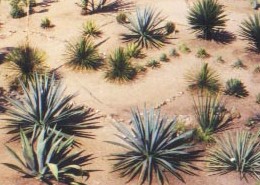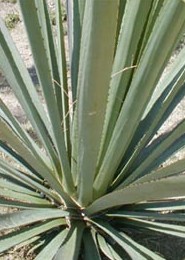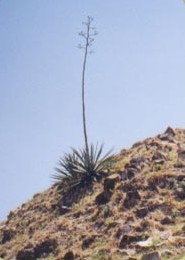
Agaves: Historical Ethnobotanic Garden, Santo Domingo Temple - Oaxaca City, Mexico

Detail - Agave in Oaxaca
The indigenous territory of the genus agave (agavaceae) spans from the Southern United States, down to South America. Mexico alone has approximately 200 varieties. Its use to humans is so expansive that Linneous, the inventor of Binomial Nomenclature (the system of classification of living organisms), was compelled to name the agave after the Greek word for “noble”. Agave has been cultivated for use by humans for clothing, food, ritualized drink (such as mezcal and pulque), and medicine for several thousands of years. The ancient Mesoamericans were the first to test the limits of its properties, but it is still widely used today. Agave is the primary ingredient in two of Mexico’s most popular and infamous exports, tequila and mezcal (the drink with the worm) and is as well the source of sisal (a fibre used to make rugs).

Agave rosette and serrated leaves
The agave goes by several common and uncommon names. It is referred to as The Century Plant, American Aloe (it is not an aloe), green cow, and Maguey (pronounced “mah-gay”). Maguey is the word the Spanish conquerors gave to the agave and the name is still in use today in Mexico. However, it was first called metl by the Mesoamerican tribe, the Nahuatl of which the Aztecs are descended. Metl was so valuable to the Aztecs that the name of the land they settled in, Mexico, actually means “those fed from the navel of the maguey”. This plant is so sacred and revered historically by the indigenous peoples of Mexico, that through mythology, religion and lifestyle it is completely rooted within the cultural history of Mexico.

A mature flowering Agave
Drink is not the only use the Aztecs made of the agave. The tender young stem and flowers of the flower stalk were roasted and boiled as food. The spines were even used as sewing needles. Fibres extracted from the leaves were used like hemp to make bags, rope, paper and musical instruments. After the conquest of Mexico by the Spanish, the fibre was used to produce harnesses, bridles and saddles for horses. The flower stalks (which are often several feet tall) have been used to produce furniture, fishing poles, and fences. The sap has been used to produce soap and for medicinal purposes as a diuretic, and to cure ulcers and bruises.
Today the culture of agave has contributed to local economies in specific areas of Mexico. Mezcal for example, is primarily produced in and around the city of Oaxaca by small, family run distilleries and growers. The drink is becoming less a novelty item purchased by tourists and more a serious alcoholic beverage appreciated by aficionados. As this continues, the industry will only grow/expand. Agave is finally coming into its own globally as the super plant the Mexican people have known it to be for over 9,000 years.